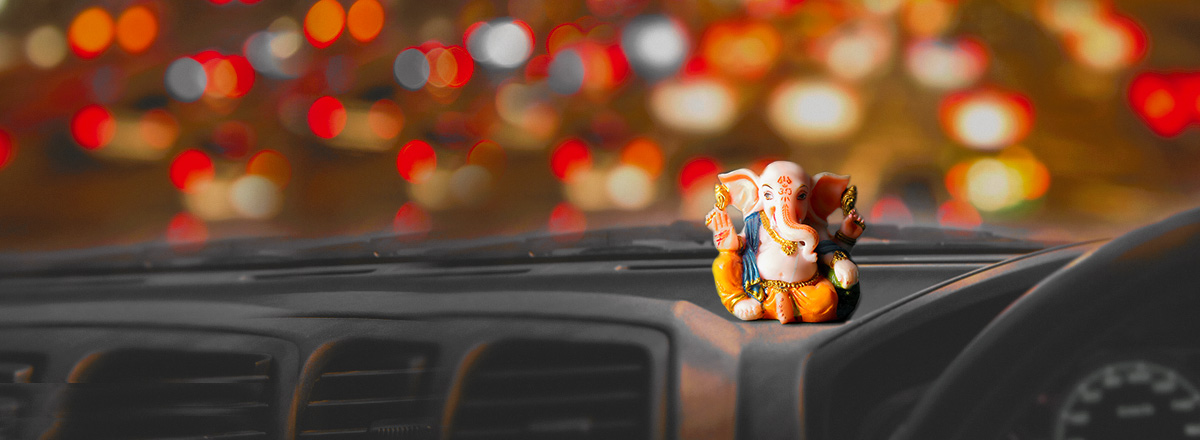What is the implied meaning of the many Names of Lord Ganapati?
Sage Mudgal has written the ‘Ganeshsahastranam’ containing the thousand Names of Lord Ganesh. The Dvadashanam verse (stotra) contains the following twelve Names of Ganapati.
प्रथमं वक्रतुण्डं च एकदन्तं द्वितीयकम् ।
तृतीयं कृष्णपिङ्गाक्षं गजवक्त्रं चतुर्थकम् ।।
लम्बोदरं पञ्चमं च पष्ठं विकटमेव च ।
सप्तमं विघ्नराजेन्द्रं धूम्रवर्णं तथाष्टकम् ।।
नवमं भालचन्द्रं च दशमं तु विनायकम् ।
एकादशं गणपतिं द्वादशं तु गजाननम् ।।
Meaning: First Vakratunda, second Ekadanta
Third Krushnapingaksha, fourth Gajavaktra
Fifth is Lambodar, sixth is Vikata
Seventh Vighnarajendra, eighth Dhumravarnam
Ninth Bhalachandra, tenth Vinayak
Eleventh Ganapati, twelfth Gajanan.
The meaning of these twelve names and some others is given below.
1. Vakratunda
Generally it is considered that Vakratunda means one with a crooked mouth or trunk. However, this is incorrect. ‘वक्रान् तुण्डयति इति वक्रतुण्ड: ।’, meaning Vakratunda is one who punishes those who follow the wrong (unrighteous) path and leads them onto the righteous path. Vakratunda is one who straightens the tiryak and visphutit frequencies, that is the crooked raja-tama predominant 360 frequencies by means of His trunk and makes them sattvik (sattva predominant) like the 108 frequencies.
2. Ekadanta or Ekashrunga
This Name is bestowed because He has only one unbroken tusk (the other is broken). Of the two tusks, the right tusk is complete while the one on the left is broken. The right side represents the surya (sun) channel (nadi). As the surya channel is effulgent, the tusk on this side of Lord Ganapati can never be broken. It is symbolic of the singular Brahman (God principle). The word dantin (दंतीन) is derived from the root dru-darshayati (दृ-दर्शयति) [meaning to show]. Thus the Name also means that He is the one who shows the direction to acquire the spiritual experience of Brahman which is non-dual. According to one school of thought, medha and shraddha (faith) are the two tusks. Medha means intellect, the ability to comprehend. Medha is the incomplete (broken) tusk and shraddha the complete one.
3. Krushnapingaksha
This word is derived from Krushna (कृष्ण) + pinga (पिंग) + aksha (अक्ष). Krushna means the one with a dark complexion, pinga means smoky and aksha means the eye. The dark complexion is in the context of earth while smoky refers to the clouds. Thus it means one who has the earth and the clouds as the eyes, that is one who can view everything on the earth and the clouds.
4. Gajavaktra
Gaja means cloud which is considered to be the representative of the dyu region (devlok) – the region of the deities. Vaktra means mouth. Thus Gajavaktra is one whose mouth is constituted by the dyu region (expansive). If Om (स्) is placed vertically, one gets the experience of Gajavadan (Ganapati). The Mudgal Puran has explained the meaning of the word ‘gaja’as ga = the principle wherein everything undergoes dissolution and ja = the principle from which everything is created. So Gaja means Brahman (God principle).
5. Lambodar
Lambodar is derived from the words lamba (large) and udar (belly). Saint Eknath has explained the meaning of this word as,
The entire animate and inanimate creation dwells within You. Hence You are called Lambodar. – Shri Eknathi Bhagvat 1:3
According to the Ganapatitantra,Lord Shiva played the Damaru (a small hour glass shaped drum). Lord Ganesh grasped the knowledge of the Vedas through the deep sound of the Damaru. He learnt dancing by watching the TanDav dance everyday and music from the sound of the anklets of deity Parvati. Since He imbibed such varied knowledge, that is digested it, He developed a large belly.
6. Vikat
Vi (वि) + krut (कृत) + akat (अकत) [akuti]. Vi means in a specific manner, krut means done and akat means the Final Liberation (Moksha). Hence, Vikat means the one who generates frequencies in a specific manner and bestows the Final Liberation.
7. Vighnesh
Vighna (विघ्न) + ish (ईश) = Vighnesh (विघ्नेश). The word ‘vighna’ is derived from ‘visheshen ghnati’ which means mainly distress. The one who controls and destroys obstacles is Vighnesh. The obstacle in this context is entrapment by the 360 (raja-tama) and 108 (sattva) frequencies. This is contrary to the aim of traversing beyond the three components (trigunatit). Ish (ईश) is derived from i (ई) + sha (श). I-ikshate (ई-इक्षते) means to watch and sha-shamayate (श-शमयते) means to cool. So Ish is the one who keeps a watch and destroys the heat generated by the 360 and 108 frequencies. Vighnaharta (vanquisher of obstacles) is another Name of Ganapati. Since Ganapati gets rid of obstacles, He is worshipped before performing any auspicious religious ceremony.
8. Dhumravarna
Dhumra means smoke. Smoke is the initial state of materialisation. It is the transitory state between the solid manifest (sagun) and the unmanifest (nirgun) states. Thus, one who possesses such a smoky complexion is Dhumravarna. According to the principle that ‘where there is smoke there is fire’, Ganapati also possesses the fire element [embers (angar)].
9. Bhalachandra
Bhal means the forehead. The frequencies arising from Prajapati, Brahma, Shiva, Vishnu and Minakshi merge into one another and produce many groups of thousands of frequencies. Though Prajapati, Brahma, Shiva, Vishnu and Minakshi are unmanifest (nirgun), Their frequencies are composed of the three components (gun). The point of origin of three of these frequencies namely those of affection, mercifulness and motherly love (ahlad) is referred to as the moon (chandra). Thus, the one who adorns such a ‘moon’ on the forehead is Bhalchandra.
Actually this is the Name of Lord Shankar. But since Ganapati is His son, it also came to be linked with Him !
Read more : http://balsanskar.com/english/lekh/160.html





